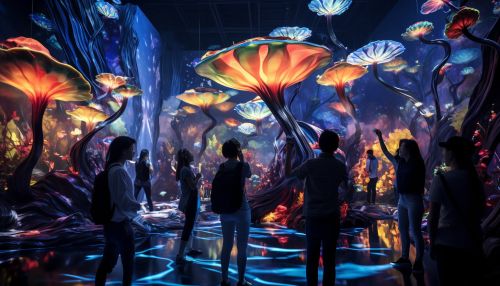Immersive art
Overview
Immersive art refers to an artistic venture that creates an all-encompassing environment, often interactive, that engages the viewer's senses in a comprehensive manner. This form of art has evolved significantly over time, with advancements in digital technology and virtual reality playing a significant role in its development and proliferation.


History
The concept of immersive art is not a new phenomenon. It can be traced back to the panoramic paintings of the 19th century, which were designed to provide viewers with a 360-degree view of a scene. These paintings were often housed in cylindrical buildings and viewed from an elevated platform in the center, creating a sense of immersion.
Types of Immersive Art
Immersive art can take many forms, including but not limited to immersive theatre, immersive digital installations, and immersive virtual reality experiences.
Immersive Theatre
Immersive theatre involves the audience in the performance in a way that traditional theatre does not. In immersive theatre, the audience is often free to move around the performance space and interact with the performers and the environment. A notable example of immersive theatre is the work of the British theatre company Punchdrunk, known for their production "Sleep No More".
Immersive Digital Installations
Immersive digital installations utilize technology to create interactive environments. These installations often use projections, soundscapes, and interactive elements to engage the viewer's senses and create a fully immersive experience. A prominent example of this type of immersive art is teamLab, a Tokyo-based art collective known for their large-scale digital art installations.
Immersive Virtual Reality Experiences
With the advent of virtual reality technology, artists have been able to create fully immersive virtual reality experiences. These experiences allow viewers to interact with the art in a virtual space, often using VR headsets and controllers. This form of immersive art has the potential to reach a wide audience, as it can be accessed from anywhere in the world.
Impact and Influence
Immersive art has a significant impact on the viewer, often evoking strong emotional responses. The immersive nature of the art allows the viewer to become part of the artwork, leading to a deeper connection and understanding of the artist's intent. This form of art also challenges traditional notions of passive viewership, encouraging active participation and engagement from the audience.
Future of Immersive Art
The future of immersive art is closely tied to advancements in technology. As virtual and augmented reality technologies continue to evolve, artists will have more tools at their disposal to create immersive experiences. Additionally, as these technologies become more accessible, it is likely that more artists will begin to explore the possibilities of immersive art.
